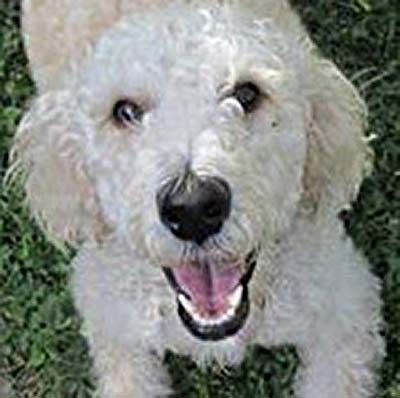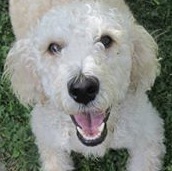
Doggy Zen is now one of your dog’s favorite exercises, and she never tries to get the treat. She understands quite well that, if she does try to get the treat, she will not get the treat. You’ve moved Doggy Zen from your hand to the floor and your dog continues to be successful. Even if the treat is lying beside your foot, right in front of her, she knows the way to get it is not to try to get it.
You’ve demonstrated to your dog, time and time again, that it’s her behavior that controls the ‘getting’ of the treat. You’ve accomplished the goal of helping your dog learn the beginning of what is called impulse control. She’s learned to control her impulse to grab a treat wherever it may be. She’s learned to wait until the treat is given to her. Your next step is to help your dog to ‘generalize’ that understanding. Eventually, you want your dog to learn that, on your cue, she should “Leave” a piece of food, an object, even another dog or human, stepping away from it so that you can reward her impulse control.
Generalizing specific behavior (like not trying to take food out of your closed hand in Doggy Zen) is a matter of life-long learning for dogs. In other words, don’t expect a light bulb to go off over your young dog’s head as she magically grasps that “Leave It” can mean not picking up a cigarette butt off the sidewalk as well as not flinging herself on your grandparent who’s just had a hip replacement.
Developing and refining a really good “Leave It” can take years, especially if you do it haphazardly and confuse your dog. Every time you flub up and the dog rewards herself by grabbing at the food item or object and taking it away, it’s steps back—many steps back—for her training.
Take the training seriously. Your job is to build up the number of times your dog is rewarded by you for the correct behavior . . . not the number of times she fails to practice impulse control and is rewarded anyway, by herself. Patience is mandatory. Don’t get bored with the lower-level steps and try to rush ahead to ‘something really difficult’ because you want to show off. It never pays!
For example, imagine that you jump from excellent responses to “Leave It” with a treat beside your foot—where you have instant control by simply stepping down on it—to using a very high-value food reward like, let’s say, a steak. You want to ‘test’ your dog! You put the steak on the floor by your foot and, before you can even straighten up, the dog is on that steak, it is in her mouth, and she’s running away to eat it.
How many repetitions of Doggy Zen with very low-value food treats (like maybe one piece of kibble) will it take to expunge that experience from your dog’s clever mind?
Many. Trust me . . . many.

In that scenario, the only one who’s failed is you, the trainer. You’ve set your dog up for an impossible task, and your training has gone out of control in a matter of seconds. Your dog now thinks the answer to getting what she wants is to be faster at it! That is not what you need.
Good training means advancing only in tiny increments . . . tiny increments in which your dog can be successful. Start with food treats (or objects) that are easiest for your dog to resist. What you want is repetition after repetition of your dog’s being rewarded for impulse control, with your advancing s-l-o-w-l-y and only when the dog can be 100% successful time and time again. Anything else is slapdash training, and you can be sure that ‘training’ will not last.
Will your dog ever be able to resist a steak just lying on the floor? Maybe—that depends on you!
Here are some suggestions for advancing your dog’s training in very small increments:
| Doggy Zen | Hold something in your hand that is more attractive to your dog than simple kibble or a plain biscuit treat. Practice a number of repetitions first with plain kibble or a biscuit piece, then—just once—use a hot dog piece instead. Your dog may immediately regress to sniffing your hand, nosing at your fingers, pawing you. Do Doggy Zen until she backs off and stops trying. Then reward. Repeat. And again. And again. When you can see your dog ‘gets’ that a hot dog piece falls under the same Doggy Zen rules as a simple biscuit, use a hot dog piece in one repetition out of ten, then more often . . . until you can use the hot dog piece each time you do Doggy Zen and, every single time, your dog waits until you reward her, making no attempt to ‘get’ the hot dog piece away from you. |
| On Floor | In the next step of Doggy Zen, use a hot dog piece on the floor. Again, start by swapping in the hot dog for the plain kibble or biscuit in one out of ten repetitions. Increase the frequency as the dog is 100% successful. (You will end up with hot dog on the bottom of your shoe, so be prepared to wipe that off when your training session is done. And please don’t leave those delicious-smelling shoes out where your dog may encounter them when you’re not around. Don’t ask for trouble!) Use only pieces of food that you can entirely cover with your shoe. Any morsel sticking out at this stage may encourage nibbling around the edges. You must control the entire piece of food! |
| Distractions | If your dog is successful as you add this new and more enticing element to your training—hot dog pieces instead of plain biscuits—consider adding a new and more distracting atmosphere. In other words, if your dog is highly successful with just you in a quiet room, consider training (one time in ten, let’s say, to start) with another person nearby, or with music playing, or in a different room. Again, as always, don’t overwhelm the dog (or yourself) with a major bump-up in distractions. Add only one individual distraction at a time; see how your dog does. If your dog reacts to the new distraction and does not succeed, go back a few steps and practice without that distraction until your dog gains more confidence. |
Success is your goal—every single time.
You are not ‘testing’ your dog. You are training your dog. Your job is to make each and every repetition of the “Leave It” behavior, no matter how simple, successful for your dog . . . and for you! Without a firm foundation of successful repetitions of the beginning steps, your dog will never be fully able to kick in her impulse control when it’s most needed.



